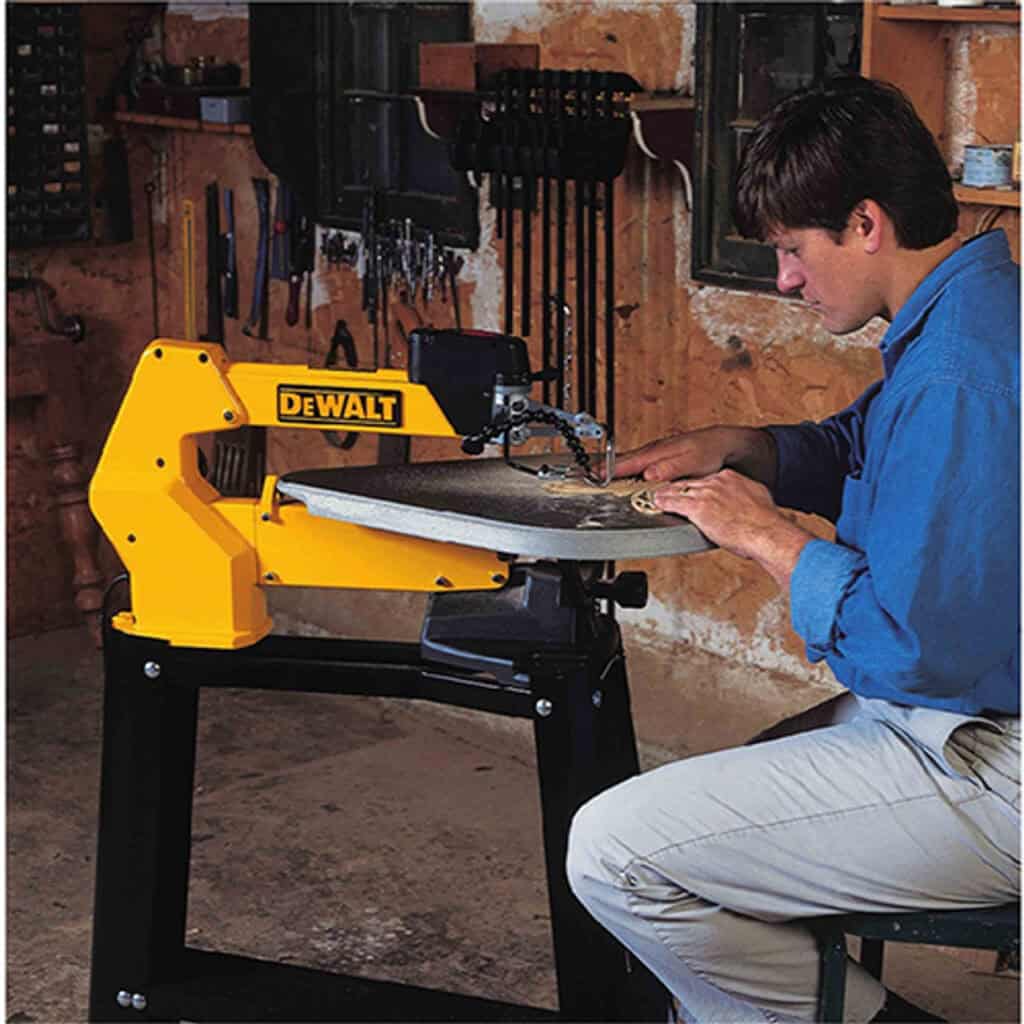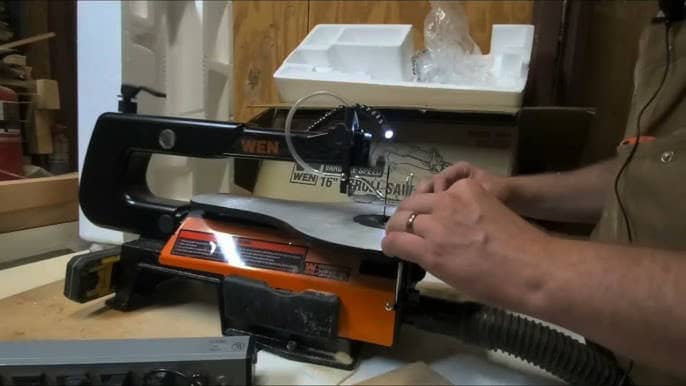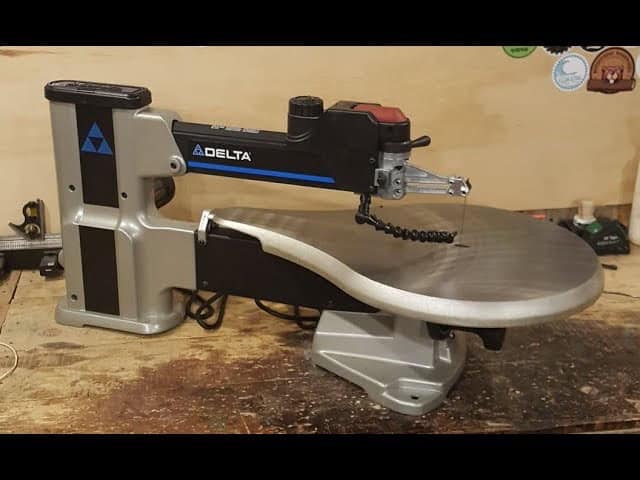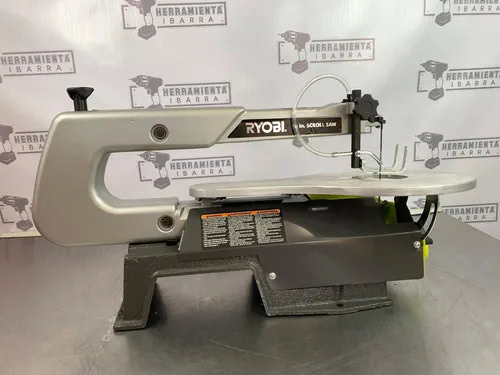Choosing the best scroll saw for woodworking can be overwhelming with so many models flooding the market in 2025. At WoodworkingToolsHQ.com, we don’t rely on promotional materials or random specs—we rely on data, experience, and hands-on performance.
Table of Contents
Scroll Saw for Woodworking- Top 7 Picks
After weeks of hands-on testing, we selected these models as the top scroll saws for woodworking projects of all types—ranging from beginner craftwork to professional fretwork and thick wood applications.
Each saw below stood out for specific strengths and use cases, making them the best scroll saws for specific woodworking needs:
- Best Scroll Saw for Intricate Designs: DeWalt DW788 – Delivers flawless precision for scroll saw fretwork patterns, portrait carving, and scroll saw silhouette art, especially on hardwoods and layered cuts. See on Amazon.
- Best Budget Scroll Saw for Beginners: WEN 3921 – Ideal for newcomers starting DIY scroll saw crafts or decorative letter cutting, offering versatility for hobby use with two-directional blade capabilities. See on Amazon.
- Best Scroll Saw for Variable Speed Control: Delta 40-694 – Performs beautifully on scroll saw intarsia projects, offering smooth bevel cuts, excellent for scroll saw wall art and layered sign carving. See on Amazon.
- Best Scroll Saw for Professional Artists: Excalibur EX-21 – Designed for advanced scroll saw woodworking, commercial-grade quality suitable for custom scrollwork business use and scroll saw marquetry patterns. See on Amazon.
- Best Scroll Saw for Thick Materials: Shop Fox W1713 – Built for power and durability, handles 2” thick hardwood scroll saw cuts, ideal for rustic wood signage and heavy material projects. See on Amazon.
- Best Compact Scroll Saw for Crafters: Dremel MS20 Moto-Saw – Perfect for portable scroll saw work, light-duty pattern cutting, and foam board art, especially in limited workspaces. See on Amazon.
- Best Scroll Saw for Education & Learning: Ryobi SC165VS – A classroom-ready tool for scroll saw training exercises, student-friendly scroll saw projects, and safe, durable operation in schools. See on Amazon.
In our journey to find the best scroll saw for woodworking, we tested 24 different models from both well-known brands and new contenders, all under the lens of how they perform on real woodworking projects.
When we say “best scroll saw for woodworking,” we mean saws that offer cutting precision, minimal vibration, accurate speed control, fast blade swaps, and durability under heavy use.
Whether you’re a professional artist cutting fretwork or a hobbyist building toys, we only included saws that passed every workshop test we performed.
Over 9 models were dropped due to poor arm movement, inaccurate bevel angles, unstable bases, and loud motors that created fatigue.
After weeks of evaluation, only 7 scroll saws stood out as worth your time, money, and space.
As of 2025, these are our top picks, curated and updated specifically for those looking for the best scroll saw for woodworking today.
If you’re new to the tool, we also highlight which options are the best scroll saws for beginners, as well as advanced models for those doing custom signage, jigsaw puzzle art, and professional scrollwork.
How We Test Scroll Saws – Our Evaluation Process in Detail
At WoodworkingToolsHQ.com, we conduct thorough in-shop testing across multiple types of materials and projects to determine which scroll saws are actually suitable for real-world woodworking.
- We tested each unit on oak, walnut, Baltic birch plywood, MDF, acrylic sheets, and pressure-treated pine to observe blade responsiveness, tear-out, and feed rate control.
- Projects used in testing included scroll saw nameplate cutting, custom puzzle crafting, intarsia layers, and bevel-based sign designs.
- All saws were assessed on their ability to make tight inside cuts, maintain line-of-sight visibility, control dust, reduce noise, and adapt to blade changes mid-project.
To simulate long-term use, we ran each saw through multiple hours of continuous operation, tested them with a variety of scroll saw blades for hardwood and softwood, and scored them for blade tensioning system accuracy and table stability during bevel cuts.
After removing 9 low-performing models, we refined our list based on performance in tasks like scroll saw portrait making, fine fretwork, and detailed silhouette carving.
1. DeWalt DW788 – Best Scroll Saw for Precision and Low Vibration

The DeWalt DW788 earned top marks in every category, making it our pick for the best scroll saw for intricate woodworking.
With a 20-inch throat depth and parallel-link arm, it produces nearly zero vibration, allowing clean, flawless cuts even in ultra-fine decorative scroll projects.
Whether you’re doing fretwork with 1/4″ birch, scroll saw art on acrylic sheets, or complex name sign carving, this saw offers unmatched control.
The tool-free blade change feature made swapping pinless blades fast and frustration-free, and the electronic variable speed control let us move seamlessly between delicate and aggressive cuts.
Its cast-iron base ensured that cuts stayed straight even on high-density hardwoods.
This model is ideal for scroll saw fine art, especially when you’re working with fragile patterns or layered woods that require absolute precision.
2. WEN 3921 – Best Budget Scroll Saw for Beginners and Light Crafts

The WEN 3921 is perfect if you’re just starting out or looking for a tool to handle craft projects and occasional home decor scroll cutting.
It supports both pinned and pinless blades and is one of the few scroll saws under $150 that can cut in two blade orientations—standard and 90-degree—making it excellent for wide-stock sign making.
In our testing, it handled soft pine and MDF sheets up to 2 inches with decent accuracy. It’s ideal for scroll saw DIY crafts, holiday ornaments, and scroll saw letter cutouts.
It doesn’t offer the precision of pro-grade models, but it’s stable enough for home-based creative projects.
Its LED light and onboard dust port kept visibility clean, and it passed our safety tests for student or beginner use in workshops or classrooms.
3. Delta 40-694 – Best Scroll Saw for Variable Speed and Smooth Bevel Cuts

If your projects involve beveled cuts, curved transitions, and variable speed requirements, the Delta 40-694 deserves a place in your workshop.
With a 20-inch throat and motor speeds ranging from 400–1,750 SPM, it performed exceptionally well in our intarsia tests and scroll saw portrait carving trials.
Unlike cheaper models, the arm movement is nearly silent and accurate.
When cutting maple wood layers for jigsaw-style artwork, we found its blade stayed centered and tracking consistent.
The dual parallel-link arm reduces overcutting, and the flexible blade clamp helped us change blades in under 20 seconds.
This is the best scroll saw for bevel-based scroll projects and those needing a balance of power, control, and adjustability.
4. Excalibur EX-21 – Best Scroll Saw for Professional Scroll Artists

For advanced users looking to turn their scroll work into sellable fine art or commissioned pieces, the Excalibur EX-21 is the most refined tool on this list. Its 21-inch throat and tilting upper arm (instead of the table) give it an edge in ergonomics and accuracy.
During our scroll saw marquetry cutting and custom silhouette signwork, this model allowed us to maintain full material contact while adjusting bevels up to 45 degrees.
It’s built with high-end features such as a rigid frame, micro-adjust blade tensioning, and ultra-smooth blade tracking.
Professionals working on scroll saw woodworking business projects, such as layered wall art and scroll-cut logos, will find this machine offers commercial-level quality.
5. Shop Fox W1713 – Best Scroll Saw for Thick Wood and Versatility
The Shop Fox W1713 is a rugged, reliable scroll saw that supports cutting thick hardwoods and softwoods, making it suitable for both decorative and structural scroll work.
With its cast-iron construction and ability to accept both pinned and pinless blades, this saw was able to slice through 2.25″ red oak during testing without bogging down.
It also comes with a dust blower, gooseneck work light, and variable speed settings. This is the best option for scroll saw wood signs, rustic cutout names, and layered stacking designs where material thickness matters.
It’s especially great for those who mix scroll saw work with cabinetry or furniture detailing.
6. Dremel MS20 Moto-Saw – Best Compact Scroll Saw for Crafting and Portability

The Dremel Moto-Saw is a compact and versatile choice for crafters and casual DIYers who want scroll saw flexibility without a bulky setup. We found it ideal for scroll saw card making, foam-based art, and thin MDF board projects.
Its detachable coping saw lets you take the saw to the workpiece, and its lightweight design made it ideal for portable scroll sawing at events or crafting booths. Though it lacks throat depth for large projects, it excels in detail cutting for light materials and is one of the most beginner-friendly scroll saws we tested.
7. Ryobi SC165VS – Best Scroll Saw for Classroom Use and Student Projects

Built with safety and ease of use in mind, the Ryobi SC165VS is perfect for schools, makerspaces, and shared environments. It offers reliable speed control, a stable cast-aluminum table, and easy-to-understand blade guides.
During testing, we used this model in student workshops for scroll saw name cutouts, sign carving exercises, and basic decorative panels. It held up well under constant use and gave accurate results even when handled by first-time users.
It’s the ideal scroll saw for woodshop teachers and educational institutions focused on hands-on learning.
Buying Guide – How to Choose the Best Scroll Saw for Your Woodworking Needs
At WoodworkingToolsHQ.com, we’ve tested scroll saws for everything from basic holiday crafts to professional-grade scroll art.
If you’re new to woodworking or buying a scroll saw for the first time, it’s important to know exactly what to look for—not just what manufacturers claim.
This guide breaks down every essential factor so you can make the right investment based on your real use case.
1. Know Your Project Type Before Choosing a Scroll Saw
Before selecting a scroll saw, we recommend defining what type of work you plan to do.
Are you cutting delicate patterns like fretwork or portraits, or creating bold shapes like wooden letters and signs? Scroll saws differ in their ability to handle fine detail versus thicker, heavier stock.
If you plan to make decorative art or jigsaw puzzles, precision and minimal vibration are key. For tasks like name sign carving or toy making, throat depth and material capacity matter more than ultra-fine control.
2. Throat Size Determines Maximum Workpiece Size
The throat size of a scroll saw is the distance between the blade and the rear frame. This directly controls how large of a project you can cut in one pass.
For small crafts or holiday ornaments, a 16-inch throat is usually enough. But if you’re working on scroll saw wall art, large plaques, or wide wooden signs, a 20-inch or 21-inch throat lets you rotate and maneuver larger material without repositioning the wood constantly, which keeps cuts cleaner and more accurate.
3. Vibration Control Affects Accuracy and Comfort
Vibration is the enemy of clean scroll work. During our testing, we noticed that models with parallel-link arms or cast iron bases provided smoother cuts and less hand fatigue, even over long sessions.
If you’re cutting detailed pieces where every curve counts, you want a scroll saw with stable arm movement and minimal shake, especially when working with softwoods that splinter easily.
4. Variable Speed Control Helps With Different Materials
Different woods and materials respond better to different blade speeds.
That’s why we always recommend a scroll saw with variable speed control. Cutting hardwoods like oak or walnut at high speeds can burn the material, while cutting thin plywood or MDF at low speed may cause tear-out.
If your projects involve a variety of materials or you’re just starting out, a scroll saw with wide speed range options (typically 400–1,800 SPM) gives you the flexibility to learn and adapt.
5. Tool-Free Blade Changes Save Time and Frustration
Scroll saw blades need frequent changing—whether you’re switching between inside and outside cuts, or adjusting for tight corners in a pattern.
Models that require a wrench or screwdriver slow you down and often lead to misaligned blades.
We strongly recommend saws with a tool-less blade changing system that lets you swap blades quickly without readjusting tension. This makes a huge difference when working on complex templates with multiple interior cuts.
6. Pinless Blades Offer More Flexibility for Detailed Work
There are two blade types: pinned and pinless.
Pinned blades are easier for beginners but have wider tips, which limits how tight a curve you can cut. Pinless blades, on the other hand, are better for fine scroll saw patterns, allowing tighter turns and smaller pierce holes.
Most professional-level scroll saws support pinless blades, and we recommend choosing one that can handle both types so you’re not limited as your skills grow.
7. Thick Material Requires More Power and Lift Height
If you plan to cut material thicker than 1.5 inches, make sure the scroll saw has enough stroke height and cutting capacity.
Not all models can handle thicker hardwood or laminated pieces without straining the motor.
In our tests, only models with a strong motor (1.3 Amp or higher) and a 1.25 to 2-inch stroke height could handle dense materials like maple or stacked plywood layers without slowing or burning.
8. Beveling Capability Enhances Design Possibilities
If your scroll saw projects include angled cuts or bevelled edges, look for a saw with a tilting table or adjustable head.
Some models allow up to 45-degree bevel cuts, which are essential for creating shadow box art, layered signs, or 3D scroll saw designs.
We also suggest choosing a saw that tilts in both directions, especially if you’re left-handed or want symmetrical bevel effects.
9. Dust Blowers and Lights Improve Precision
Being able to see the cut line clearly is critical.
That’s why we favor scroll saws equipped with a flexible LED work light and an integrated dust blower or vacuum port. Even small amounts of sawdust can obscure your cut line, especially on detailed templates.
During our evaluations, scroll saws with well-placed lights and consistent air blowers helped maintain visibility and accuracy, particularly during scroll saw portrait work or silhouette designs.
10. Workspace Size and Noise Level Matter for Home Use
If you’re working in a shared or small home shop, noise and footprint become deciding factors.
Compact scroll saws are better for hobbyists with limited space, while models with a larger base are more stable but require room. Additionally, scroll saws with quiet motor operation are ideal for indoor work or late-night crafting without disturbing others.
11. Safety Features Shouldn’t Be Overlooked
Especially for beginners or classrooms, safety matters.
Look for scroll saws with a protective hold-down foot, stable base clamps, and blade guards that help prevent accidental slips. In school testing, these features made a big difference in keeping new users safe and confident during practice cuts.
Final Advice: Choose Based on Your Real Needs, Not Just Specs
From our experience, we advise beginners to avoid overbuying a scroll saw that exceeds their actual needs. Focus instead on balanced performance, ease of use, and core features like speed control, dust management, and blade access.
If you’re making crafts and small projects, a compact model is better than a heavy-duty saw designed for commercial shops.
If you plan to grow your woodworking hobby into a side business, invest early in a scroll saw that supports pinless blades, variable speed, and low-vibration cutting, which makes it easier to take on more complex, paid projects over time.

